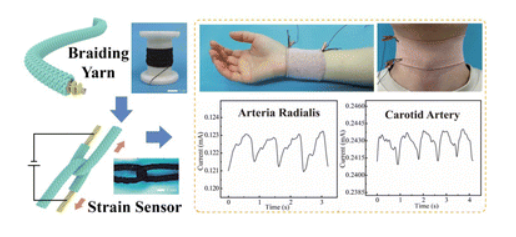Knotted fiberbased strain sensors with tunable sensitivity and a sensing region for monitoring wearable physiological signals and human motion
Abstract: Knotted fiberbased strain sensors with tunable sensitivity and a sensing region for monitoring wearable physiological signals and human motion Fiberbased strain sensors break the boundaries of flexible wearable electronics and smart clothing due to their unique functionality and weavability. The traditional resistive strain sensors achieve resistance increase by designing the “separation mode” of conductive network nodes under strain, which has the potential risk of uncontrollable separation gaps and sensing component failure. Herein, a new type of fiber based strain sensor was developed by designing a knot structure to transform the axial strain to a tension that was then turned to resistance changes. The novel fiber-based sensor realized a resistance change by strain-induced aggregation of the conductive network nodes instead of the “separated mode” from traditional strain sensors, resulting in a resistance decrease under strain (opposite to traditional strain sensors with resistance increasing under strain). The GF and the linear sensing region were effectively adjusted by altering the stretching ability of the BSYs which significantly affect the electric response as well as the strain–tension transition efficiency. The highest GF of up to 267.7 was achieved with BSY-60 while the widest sensing region reached 88.4% with BSY-90. The strain sensor also exhibited a fast response/recovery time of 0.3/0.2 s and great durability. At last, the sensor was combined with common fabric straps and then attached to different parts of the human body to detect various pieces of physiological information such as pulse and movement, which indicates the great application potential in the fields of smart medical care, sports, and fitness.

Zhong WB, Liu WW, Ke YM, et al. An ultrafine spiderlike carbon nanonet for high performance air filters, health monitoring sensors,and green energy generators†[J].Journal of Materials Chemistry C.